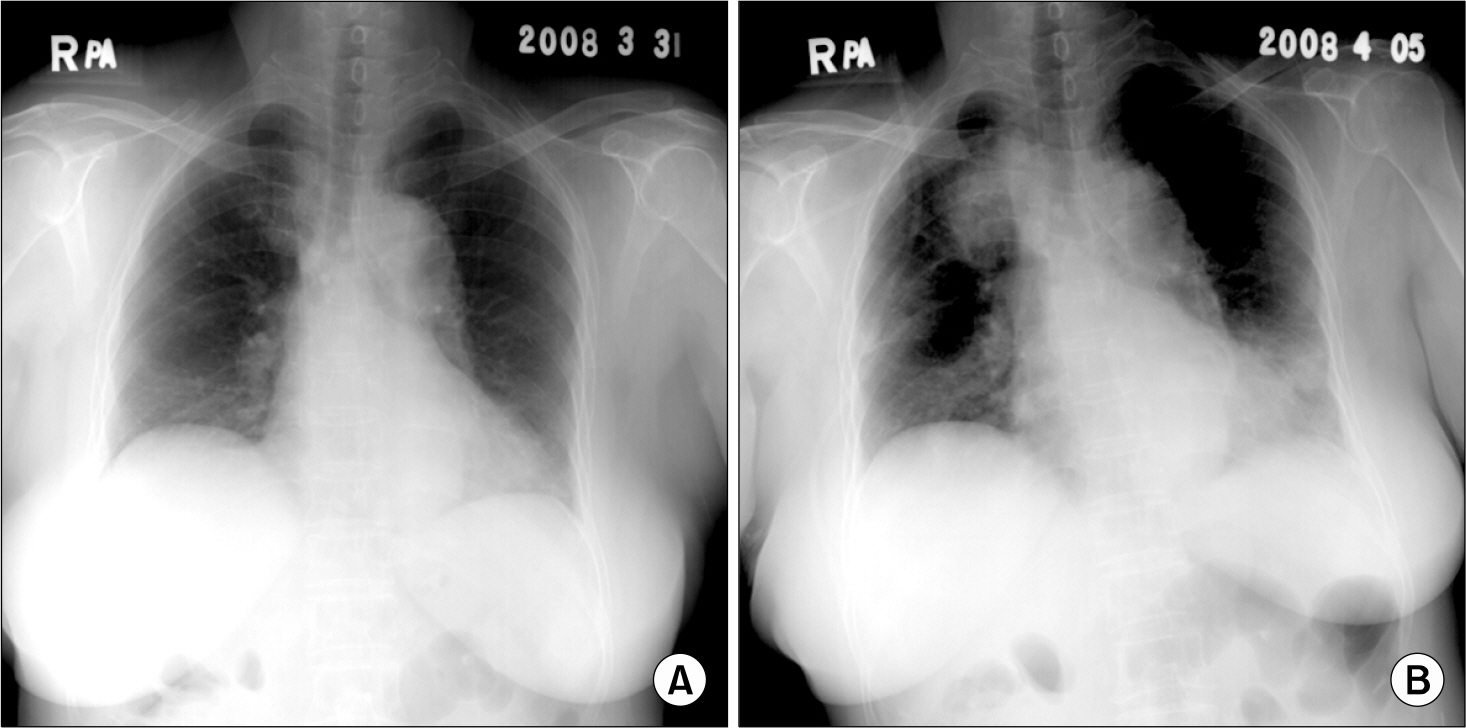Korean J Hematol.
2009 Sep;44(3):168-171. 10.5045/kjh.2009.44.3.168.
A Case of Hantavirus Pulmonary Syndrome Mimicking Apalastic Anemia with Invasive Aspergillosis
- Affiliations
-
- 1Department of Internal Medicine, College of Medicine, Inje University, Sanggye Paik Hospital, Seoul, Korea. yj-yuh@paik.ac.kr
- 2Department of Pathology, College of Medicine, Inje University, Sanggye Paik Hospital, Seoul, Korea.
- 3Department of Laboratory Medicine, College of Medicine, Inje University, Sanggye Paik Hospital, Seoul, Korea.
- KMID: 2252137
- DOI: http://doi.org/10.5045/kjh.2009.44.3.168
Abstract
- Hantavirus is known to a causative agent of hemorrhagic fever with renal syndrome and it can cause hantavirus pulmonary syndrome, a rare disease in Korea. Hantavirus pulmonary syndrome is usually associated with pulmonary hemorrhage and fever. The common hematologic features of this syndrome are elevated hematocrit level, leukocytosis and thrombocytopenia. We report a case of hantavirus pulmonary syndrome with pancytopenia. This patient with severe neutropenia with pulmonary infiltration mimicked aplastic anemia with invasive aspergillosis.
MeSH Terms
Figure
Reference
-
References
1. Young NS. Acquired aplastic anemia. Ann Intern Med. 2002; 136:534–46.
Article2. Hahn JS. Immunopathogenesis of aplastic anemia. Korean J Hematol. 1985; 20:87–94.3. Lee HW, Lee PW, Johnson KM. Isolation of the etiologic agent of Korean Hemorrhagic fever. J Infect Dis. 1978; 137:298–308.
Article4. Duchin JS, Koster FT, Peters CJ, et al. Hantavirus pulmonary syndrome: a clinical description of 17 patients with a newly recognized disease. The Hantavirus Study Group. N Engl J Med. 1994; 330:949–55.5. Muranyi W, Bahr U, Zeier M, van der Woude FJ. Hantavirus infection. J Am Soc Nephrol. 2005; 16:3669–79.
Article6. Khan AS, Ksiazek TG, Peters CJ. Hantavirus pulmonary syndrome. Lancet. 1996; 347:739–41.
Article7. Kim MS, Lee SH, Park JW, Do J, Yoon KW. A case of hantavirus pulmonary syndrome with hemorrhagic fever with renal syndrome. Korean J Med. 2007; 73:651–5.8. Kim YS, Jee YK, Bai SJ, Yun SC, Kim KY. A case of hantavirus pulmonary syndrome. Tuberc Respi Dis. 1997; 44:1382–9.9. Osaki M, Matsubara K, Iwasaki T, et al. Severe aplastic anemia associated with human parvovirus B19 infection in a patient without underlying disease. Ann Hematol. 1999; 78:83–6.
Article10. Zaki SR, Greer PW, Coffield LM, et al. Hantavirus pulmonary syndrome. Pathogenesis of an emerging infectious disease. Am J Pathol. 1995; 146:552–79.11. Peters CJ, Simpson GL, Levy H. Spectrum of hantavirus infection: hemorrhagic fever with renal syndrome and hantavirus pulmonary syndrome. Annu Rev Med. 1999; 50:531–45.
- Full Text Links
- Actions
-
Cited
- CITED
-
- Close
- Share
- Similar articles
-
- Hemorrhagic fever with renal syndrome and coexisting hantavirus pulmonary syndrome
- Invasive Pulmonary Aspergillosis Invaded to Thoracic Vertebra in a Immunocompetent Host: A case report
- A Case of Endobronchial Aspergillosis Completely Obstructing Lobar Bronchus
- Invasive Pulmonary Aspergillosis Histologically Mimicking Mucormycosis
- A Case of chronic necrotizing pulmonary aspergillosis with pulmonary artery aneurysm





